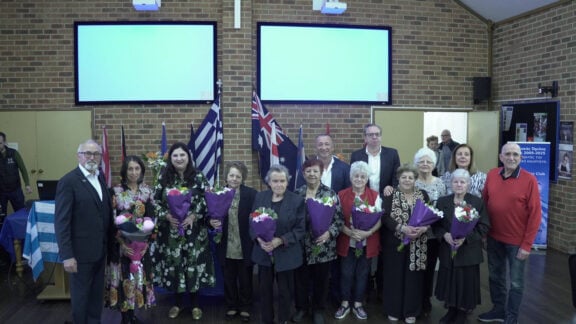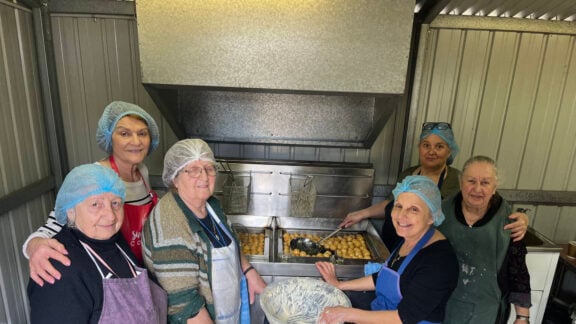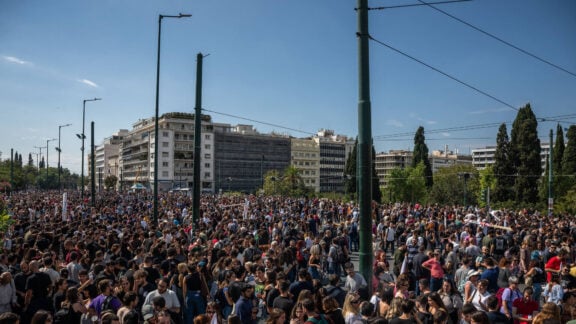It’s early 2000s. A young photographer enters the Greek Community building on Melbourne’s Lonsdale Street and introduces herself.
“I said, you know, I’d love to get to know my community and maybe I can take some photos for you,” Georgia Metaxas says.
It worked and she began by shooting Greek festivals and events. That allowed her to go deeper into her community for what was to become important ethnographic photography.
“I grew up kind of a bit separate to the Greek community and my camera was my entry point into it.”
She soon had her work published in Neos Kosmos.
“I have very rich and fond memories alongside the Greek community. I was very fortunate. So, it feels quite nice to be returning to it in a way.”

From London back home, one more Ithaca
Metaxas, who has been living in London and lecturing at Falmouth University had a selection of the images in her debut book, shown recently at the Centre for Contemporary Photography in Melbourne.
“They had an exhibition called ‘Walking through the darkness’, and it was all about photography’s relationship to the dark.
“People think about photography in relationship to the light, but actually photography has a really interesting relationship to the dark.”
This is one of the concepts underpinning the book coming out in May, she says, as she starts revealing why ‘Mnemosyne Grove’ is her “most personal project to date”.

She worked with extended family on it and the project connects the Ionian Sea: her mother’s Peloponnese village Palairos, and her father’s ancestral island, Ithaca.
“In 2017, my uncle Mimi mentioned in passing that there was an olive grove that had been bequeathed to my mother’s family with big old trees, some that he thought were between around 500 years old, and that they were named after the women in the family,” Metaxas says of how the Palairos part of the project started as an idea that would realise three years later.
“I think people have a concept of photography being fast paced, but for me, it’s a very slow.”

An olive grove ‘road trip’ in Palairos was complemented by another in Ithaca her father’s island, before migrating to Australia on a British steamship in 1901.
‘Roadtrips’ meant time in the field, getting to know the land and the stories behind it. Of course, also the stories her family. The olive tree portrait shots became a narrative of memory, and timelessness.
Her guides were her elders. Uncle Mimi and his friends in Palairos and Ithaca, and Demitri Petalas who knew her grandfather Gerassimos Metaxas.
The Ithacan trip added another layer of meaning for the artist.

She retraced her father’s footsteps, who died young while on his first and only time in Greece in the late 1970s.
“We went over as a family when I was two, and he didn’t return.
“It was our first family trip and he died in my mum’s village where the olive trees were. I think he was 36 or 37. He passed away suddenly.
Her father’s death wasn’t the impetus of the olive tree project though, the photographer says.
“The trees were.”
“As it happened, he had filmed olive trees on Ithaca.
“I came across my father’s images and a super eight film he had taken on that family trip which I had completely forgotten about.”
“My grandfather Gerassimos, with a stick, was pointing to the olive trees and showing my father the location of the olive trees.”

Having access to those photographs her father had taken feels like ‘a gift’ says Metaxas.
“They have rekindled my photography practice, and I almost think of it as a co-authorship, you know, that I’m publishing his work in the book.”
As much as this photographic project is a personal inquiry into her family, Metaxas believes there is a universal theme of storytelling is photography is part of photography and people relate to it.

The tree of life
The olive tree. the tree of life for the Mediterranean and the Levant, is the protagonist .
The women in her mother’s family, became very central to the project. They had six of the trees named after them.
The book’s sequence follows a visual structure adapted from the rhythmic structure of Homer’s epic poem ‘The Odyssey’.
“Which sounds ludicrous when I say it out loud, but that’s what happened, and it felt right to borrow it. I hope he doesn’t mind.” Metaxas says with a smile tone then turning serious.
“Actually some of the [olive grove] land is in close proximity of the hill called ‘Homer’s school’. It’s something I’ve been thinking about for years, it was just the right time,” she says of her wish to pay tribute to Ithaca’s land.

‘Mnemosyne Grove’, a grove of memories, also pays homage to the ancient Greek deity for memory.
“That’s what it means basically, a grove of memory.
“There is this whole thing of traversing a path traversed before by other people. But also, arboreal time, the time of the trees” ,” she says.
Olive trees which can live for hundreds of years are a perfect aid for memory and marking time. They are repositories of memory.
“Some of those olive trees have existed for 500 years, so when you spend time in a place like an olive grove, you can’t help but think about time. Then the world slows down, in a very nice way.
“Slowing down is something that we all need, I think, and artists are here to help have that conversation.”









